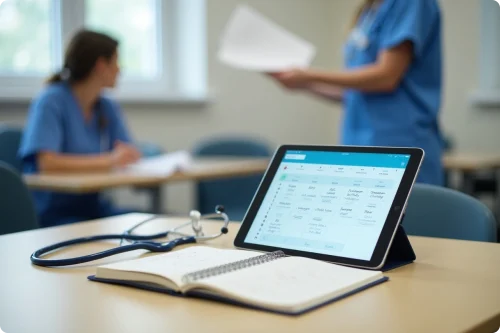Modern ERP LMS Solutions for Nursing Colleges : Bridging Academics and Clinical Training
Introduction
Unlike most academic disciplines, nursing blends theory with practical hospital training. Students may attend lectures in the morning, practice procedures in labs by afternoon, and complete hospital postings by evening. This complexity makes coordination difficult for colleges. When institutions rely on manual logs or separate tools for academics and training, errors occur. Misplaced attendance sheets, conflicting schedules, and late communication affect both students and faculty. vmedulife ERP LMS for Nursing Colleges resolves these issues by bridging academics and clinical training on a single digital platform.
1. Connecting Academic Learning with Clinical Practice
A successful nursing education must balance textbooks with real-world clinical exposure. ERP LMS brings both together on one platform. Students can access digital lecture materials, practice assessments, and clinical case studies while also maintaining digital clinical logs. Administrators gain centralized oversight of academic performance and clinical compliance requirements. This integration ensures that learning is holistic, preparing nursing students to confidently handle patient care while keeping their academic progress aligned with institutional standards.
2. Clinical Training Management & Competency Tracking
Clinical training is at the heart of nursing education. ERP LMS allows students to record clinical hours, log patient interactions, and track skill competencies digitally. Faculty can monitor each student’s performance against required benchmarks, provide structured feedback, and generate accurate reports for accreditation purposes. This structured tracking ensures that every student develops the necessary clinical expertise before entering the healthcare workforce. Nursing colleges benefit by producing competent, practice-ready professionals whose academic and clinical performance is continuously monitored and improved.
3. Streamlined Academic & Administrative Operations
Nursing colleges handle multiple functions—admissions, fees, timetables, attendance, and examinations. Modern ERP LMS simplifies these processes by providing online application portals, automated fee systems, digital attendance, and centralized records. This reduces manual errors, enhances transparency, and saves valuable time for staff and students. Faculty can focus on teaching and mentoring while administrators get real-time dashboards for informed decision-making. Streamlined operations not only improve efficiency but also build trust with students and parents, ensuring the institution remains competitive and credible.
4. Faculty Empowerment for Better Student Outcomes
Faculty members play a dual role in nursing colleges—academic instructors and clinical mentors. ERP LMS supports them with student dashboards, lesson planning tools, and mentorship features. They can identify academic gaps, track clinical skill progress, and guide students with personalized interventions. Automated scheduling, digital exam management, and workload distribution also reduce faculty burden. With less time spent on administrative tasks, faculty can dedicate more effort to teaching and skill-building. This results in stronger student outcomes and a more engaged learning environment.
5. Data-Driven Insights & Accreditation Support
Continuous improvement is possible only through actionable insights. ERP LMS provides real-time analytics on academic performance, clinical outcomes, attendance, and administrative workflows. Nursing colleges can use these insights to improve resource allocation, identify student challenges early, and strengthen overall academic quality. For accreditation and compliance, ERP LMS offers ready-to-use reports that align with regulatory requirements. This data-driven approach ensures that institutions remain ahead in quality assurance, while also adapting to evolving educational and healthcare standards.
Challenges Faced by Nursing Colleges
1. Managing Clinical Records
Each nursing student must log hundreds of hours in hospital training. Manual documentation often leads to missing entries or unverified records.
2. Communication Delays
Notice boards and emails are ineffective when schedules change suddenly. Students need instant updates.
3. Tracking Practical Performance
Unlike written exams, clinical skills require continuous monitoring. Without digital tools, performance evaluation is inconsistent.
ERP LMS in Action for Nursing Colleges
- Course Management
Organize subjects, credits, and academic calendars with precision. Avoid overlapping lectures and postings. - Clinical Practice Records
Digitally log hospital hours, supervisor evaluations, and skills demonstrated. These records are ready for audits anytime. - Assessment Tools
Conduct both theory exams and clinical evaluations. Generate automated results and progress charts for students. - Communication Hub
Send instant notifications for schedule changes, announcements, or circulars. Parents also receive updates directly.
Benefits of ERP LMS
- Transparency
Every stakeholder has access to updated, accurate information—students track progress, faculty monitor workload, and management oversees operations. - Collaboration
ERP LMS strengthens collaboration between hospital supervisors, faculty, and students through digital feedback mechanisms. - Efficiency
Paperwork reduces drastically. Reports that once took weeks are available instantly. - Resource Utilization
Labs, classrooms, and hospital tie-ups are allocated efficiently without overlaps.
Stakeholder Impact
Students : Gain clarity on academics and hospital postings. Receive digital resources and maintain verified training records.
Faculty : Simplify workload distribution, monitor student performance, and reduce repetitive tasks like attendance.
Administrators : Monitor all operations from a single dashboard. Generate regulatory reports instantly.
Parents : Stay informed about student progress and attendance, even during clinical postings.
Real-Life Scenario
A batch of 200 nursing students is posted across three hospitals. Traditionally, coordinators chase after attendance registers, collect supervisor remarks, and manually calculate training hours. Mistakes are common.
With vmedulife ERP LMS, students’ hospital postings are updated digitally. Supervisors submit evaluations online. Administrators see the data in real time, eliminating errors and last-minute chaos during inspections.
Conclusion
Modern challenges in nursing education require modern solutions. By integrating academics and clinical training, ERP LMS for Nursing Colleges ensures that institutions prepare students holistically while simplifying administration. Nursing colleges ready to modernize operations and build trust with regulators, students, and parents should implement vmedulife ERP LMS today.

